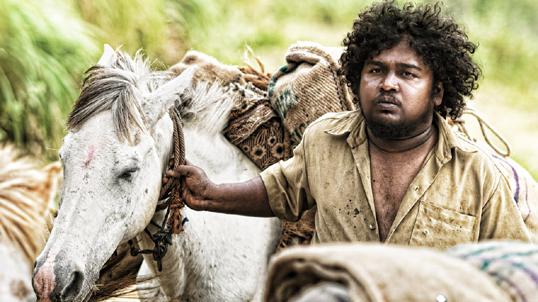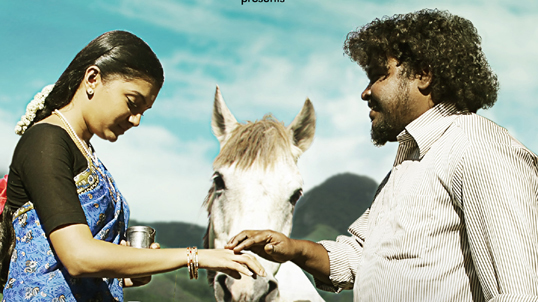
A scene from Suseendran's satire Azhagarsamys Horse.
Azhagarsamy’s Horse directed by Suseendran is a Tamil movie screened at the 36th Toronto International Film Festival (TIFF) under the Special Presentation category.
The film begins with a picturesque backdrop of a tiny village, Malliyapuram, in Southern India. When the sun rises over the hills breaking the dawn, the drummer announces the feast of the village temple.
The message goes around mouth-to-mouth and the excitement and the enthusiasm of people of all ages show they are longing for this great event. They get ready for the big day of the year by stitching new clothes, preparing special food and cleaning up their gardens.
Temple president and his helpers start collecting charity going from door to door. Villagers give generously for the temple collection.
On the festival day everybody enjoys meeting each other freely. The following day, the wooden horse which supposed to carry the statue in the temple goes missing. It used to stand in front of the temple in an open space (verandha).
People think this would bring bad luck to the village and start looking for it everywhere and even report to the police station in the city. At the same time, group of people fi nd a real horse abandoned near a waterfall. They think the wooden horse has come to life and take the horse to the temple, tie it and look after it until the day of the festival.

The bride says she will not marry anybody else other than the horse owner.
Director Suseendran who was born in South India unfolds very successfully a real life story which took place in the 1980s in very lively and warm rural settings. He highlights the beauty of the nature as well as good and bad sides of human nature in a very realistic manner without excessive cinematic and artificial gimmicks. Azhagarsamy’s Horse is his third Tamil feature film. Suseendran unfolds another story going on in a nearby village in the mountains.
A horse owner has gone to see a bride and daydreams of his wedding day to bring home his beautiful bride. His horse goes missing and he goes to inform the bride’s family about the misfortune. There isn’t any sympathy waiting for him in brides home. Bride’s father says, “How can you take care of my daughter without your horse. The horse is your livelihood…Go and find your horse and come back before the next full moon day to fix another day for the or I will have to find another groom for my daughter.”
Heartbroken, the horse owner climbs to the top of the mountain and calls the horse at the top of his voice. Disappointingly, only the loud voice echoes through the valleys. He walks to the nearby village and sees his horse tied up in front of the temple. When he tries to take his horse back, villagers beat him mercilessly. One kind-hearted woman comes up and stops the beating. She says,” You Godfearing people beat this man in front of the temple?”
Ultimately, villagers compromise with horse owner to return the horse after the final rituals of the temple. Former president of the temple arrives with his men to grab some money from the collection and he sees the horse and plans to kill the owner on the eve of the festival to get the horse after the festival.
There is also a limit for injustice and cruelty. Even an animal cannot stand it anymore, the horse owner’s devotion, sacrifice and honesty overpowers evil. He bravely faces obstacles on his way in an undefeated manner to get his horse back.

At the end, when the horse owner returns home he fi nds his horse in the front yard. He is dancing in joy to the accompaniment of Illiyarajas haunting music. The festive type of song is sure to stay alive for some time.
One person in the village watches all the chaos happening just before the final day of the temple festival and decides to return the wooden horse which he robbed from the temple.
The festival takes place carrying the God’s statue on the horse to the nearby river. Temple president’s son gives money to a father who is in tears waiting to give away his daughter in marriage and he gets married to the girl as promised.
When the president of the temple hears the story of his son’s marriage he raises his hand to the sky and says, “Oh! What happened? This marriage is not compatible. We will never get the rain this year too”.
As soon as his words end the rain starts with a thunder storm.
This reminds me the saying in Pali “Devo wassathu kalena raja bavathu dhammiko.” (When the administration is just and fare, God sends showers in time)
